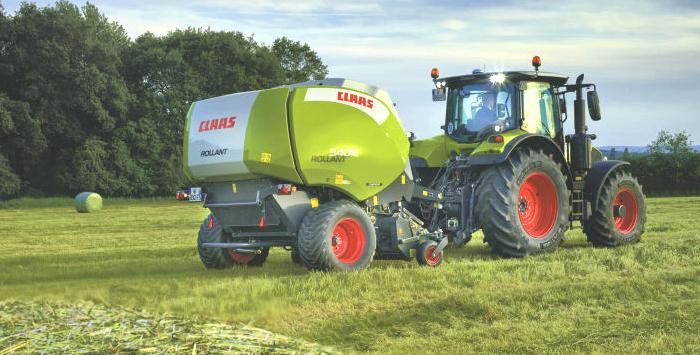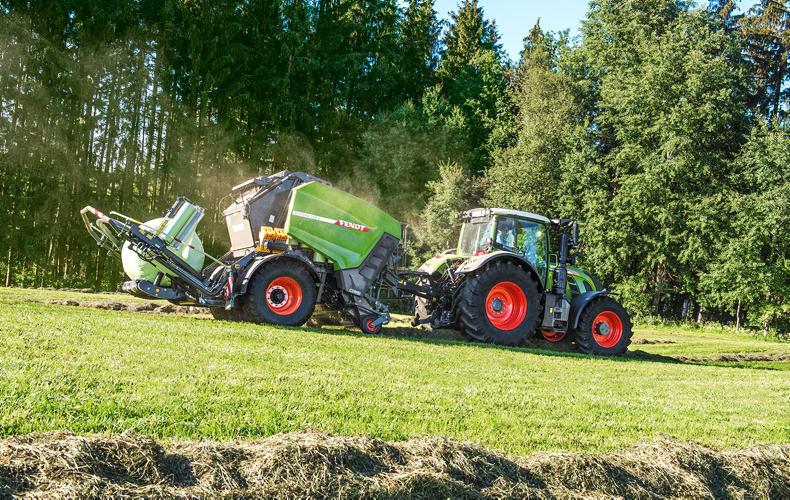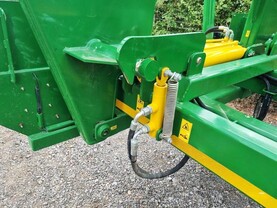John Deere variable chamber combi
The C451R and C461R variable-chamber baler/wrapper combination units are the latest additions to John Deere’s round baler range. As with the existing C441R fixed-chamber model, the C451R and C461R feature a full-frame chassis.
These balers will continue to use the Fast Release System first introduced on the 900 Series round balers in 2012, in conjunction with a high-capacity feeding system. John Deere claims that their main focus in the balers’ design has been on their ability to work in heavy, wet grass crops in addition to meeting today’s customer needs for dry straw. The machines can produce bales up to 1.85m in diameter.
Pickup
The pickup reel has a five tine bar cam track design with 6mm tines. The machine is fitted with a new reinforced wear-resistant Hardox steel rotor. There is a choice of feeding systems using the MaxiCut HC rotor with either 13 or 25 knives, controlled from the cab.
Both versions have a full-width parallel drop-floor system operated from the tractor cab, which enables blockages to be removed instantly.
John Deere claims that the C451R and C461R feature a 15% faster wrapper working at 40rpm and an 18% faster table transfer system compared to the previous C440R model. The new models come with a tandem axle as standard.
McHale recording functions
For the coming season, McHale has introduced the option of a recording function on the Fusion 3 plus machines to measure some of the variables of a bale.
These options allow the operator to provide a recording of the average bale moisture content and the average bale weight of a job completed for a customer. This information is displayed on the McHale iTouch control console and can also be printed using a receipt printer which is available as an option.
Bale weighing function
As the bale is being tipped, the bale weight is recorded before placing the wrapped bale on the ground. The weight of each bale is accumulated and the average bale weight for the job is displayed in the customer profile section on the iTouch control console and on the job receipt.
A bale moisture sensor can also be fitted as an option. This sensor is positioned in the side wall of the bale chamber. Once the PTO speed is above 400rpm, a live crop moisture value is displayed on the screen throughout the baling process.
An average moisture content reading of the bale will be displayed on the iTouch control console. This average value is then accumulated in the on-screen customer profile and on the job receipt. A receipt printer can be fitted to the iTouch control consoles on new Fusion 3 Plus machines as an optional extra.
Claas Rollant 540

The new Rolant from Claas has a stronger chassis, new rollers and offers the option of either net or film wrapping.
Claas recently unveiled an updated Rollant 540 fixed-chamber round baler, 43 years after first introducing the first Rollant back in 1976. The latest baler in the Rollant range has a stronger chassis, new rollers, and offers the option of either net or film wrapping.
New rollers
The updated Rollant has a redesigned baling chamber including 15 rollers that are manufactured from 4mm thick steel plate and have double race bearings. The drive sprockets now use a roller spline system. The rams for the back door are located horizontally on both sides of the baler, to reduce the pressure and stress exerted on the tailgate and ram components.
The updated Rollant comes with beefed-up running gear, including both chains and sprockets. The main drive and rotor are fitted with 35mm (1.25in) chains while the tailgate rollers are driven with a 25mm (1in) chain.
To help reduce the stress on the chains, the roller sprockets are larger in diameter, meaning more of the chain will be in contact with the sprocket teeth at any given time. The chains are lubricated by an eccentric pump. The lubrication interval can be altered from the control terminal. All the lubricating nipples of the MPS and tailgate are combined on the right-hand side.
Pickup reel
The Rollant 540 is fitted with a 2.10m wide pickup reel with two lateral feed augers feeding the rotor. The baler’s optional chopping mechanism has 15 knives which can be swung in from the cab, and have individual protection against collisions with foreign objects. The new Rollant baler can apply either net or film wrapping. For operating the baler, Claas has offered a choice between three options – the Claas Communicator, the Operator terminal or the Isobus terminal.
Fendt Rotana

The new Fendt Rotana has a split driveline, meaning two chains come off the main drive roller instead of one.
AGCO, the parent company of Fendt, purchased Lely’s forage range of equipment two years ago. Fendt’s new generation of round balers are based on the Lely machines but have integrated a number of new features.
The Rotana now has a freewheel sprocket that can rotate a full 360°, protecting the driveline if a blockage occurs. In the event of a blockage, the sprocket will continue to spin and the bale can slow down and run out until it comes to a halt.
The new drive concept of the Rotana features a split driveline, meaning two chains come off the main drive roller instead of one. As each of the two chains drive each roller, the power is distributed evenly. Fendt has also installed a sensor capable of measuring the uniformity of the bale density.
For the final 30% of the bale fill, an indicator on the terminal will aid the driver to achieve a uniform bale shape. Other new features include a dirt wiper for the roller bearings, new exterior panels and the balers are now Isobus-compatible.
The new Rotana combi baler/wrapper is available in a fixed-chamber version as the 130F Combi or the variable chamber 160V Combi. These combi balers have evolved from the Lely Tornado.
The new combi range features a moving arm that transfers the bale from the chamber to the lower table. To prevent slippage, the bale transfer ramp is equipped with moving side parts. Fendt has reduced the tilt angle of the main chamber to 8° in an attempt to improve stability on slopes.
John Deere variable chamber combi
The C451R and C461R variable-chamber baler/wrapper combination units are the latest additions to John Deere’s round baler range. As with the existing C441R fixed-chamber model, the C451R and C461R feature a full-frame chassis.
These balers will continue to use the Fast Release System first introduced on the 900 Series round balers in 2012, in conjunction with a high-capacity feeding system. John Deere claims that their main focus in the balers’ design has been on their ability to work in heavy, wet grass crops in addition to meeting today’s customer needs for dry straw. The machines can produce bales up to 1.85m in diameter.
Pickup
The pickup reel has a five tine bar cam track design with 6mm tines. The machine is fitted with a new reinforced wear-resistant Hardox steel rotor. There is a choice of feeding systems using the MaxiCut HC rotor with either 13 or 25 knives, controlled from the cab.
Both versions have a full-width parallel drop-floor system operated from the tractor cab, which enables blockages to be removed instantly.
John Deere claims that the C451R and C461R feature a 15% faster wrapper working at 40rpm and an 18% faster table transfer system compared to the previous C440R model. The new models come with a tandem axle as standard.
McHale recording functions
For the coming season, McHale has introduced the option of a recording function on the Fusion 3 plus machines to measure some of the variables of a bale.
These options allow the operator to provide a recording of the average bale moisture content and the average bale weight of a job completed for a customer. This information is displayed on the McHale iTouch control console and can also be printed using a receipt printer which is available as an option.
Bale weighing function
As the bale is being tipped, the bale weight is recorded before placing the wrapped bale on the ground. The weight of each bale is accumulated and the average bale weight for the job is displayed in the customer profile section on the iTouch control console and on the job receipt.
A bale moisture sensor can also be fitted as an option. This sensor is positioned in the side wall of the bale chamber. Once the PTO speed is above 400rpm, a live crop moisture value is displayed on the screen throughout the baling process.
An average moisture content reading of the bale will be displayed on the iTouch control console. This average value is then accumulated in the on-screen customer profile and on the job receipt. A receipt printer can be fitted to the iTouch control consoles on new Fusion 3 Plus machines as an optional extra.
Claas Rollant 540

The new Rolant from Claas has a stronger chassis, new rollers and offers the option of either net or film wrapping.
Claas recently unveiled an updated Rollant 540 fixed-chamber round baler, 43 years after first introducing the first Rollant back in 1976. The latest baler in the Rollant range has a stronger chassis, new rollers, and offers the option of either net or film wrapping.
New rollers
The updated Rollant has a redesigned baling chamber including 15 rollers that are manufactured from 4mm thick steel plate and have double race bearings. The drive sprockets now use a roller spline system. The rams for the back door are located horizontally on both sides of the baler, to reduce the pressure and stress exerted on the tailgate and ram components.
The updated Rollant comes with beefed-up running gear, including both chains and sprockets. The main drive and rotor are fitted with 35mm (1.25in) chains while the tailgate rollers are driven with a 25mm (1in) chain.
To help reduce the stress on the chains, the roller sprockets are larger in diameter, meaning more of the chain will be in contact with the sprocket teeth at any given time. The chains are lubricated by an eccentric pump. The lubrication interval can be altered from the control terminal. All the lubricating nipples of the MPS and tailgate are combined on the right-hand side.
Pickup reel
The Rollant 540 is fitted with a 2.10m wide pickup reel with two lateral feed augers feeding the rotor. The baler’s optional chopping mechanism has 15 knives which can be swung in from the cab, and have individual protection against collisions with foreign objects. The new Rollant baler can apply either net or film wrapping. For operating the baler, Claas has offered a choice between three options – the Claas Communicator, the Operator terminal or the Isobus terminal.
Fendt Rotana

The new Fendt Rotana has a split driveline, meaning two chains come off the main drive roller instead of one.
AGCO, the parent company of Fendt, purchased Lely’s forage range of equipment two years ago. Fendt’s new generation of round balers are based on the Lely machines but have integrated a number of new features.
The Rotana now has a freewheel sprocket that can rotate a full 360°, protecting the driveline if a blockage occurs. In the event of a blockage, the sprocket will continue to spin and the bale can slow down and run out until it comes to a halt.
The new drive concept of the Rotana features a split driveline, meaning two chains come off the main drive roller instead of one. As each of the two chains drive each roller, the power is distributed evenly. Fendt has also installed a sensor capable of measuring the uniformity of the bale density.
For the final 30% of the bale fill, an indicator on the terminal will aid the driver to achieve a uniform bale shape. Other new features include a dirt wiper for the roller bearings, new exterior panels and the balers are now Isobus-compatible.
The new Rotana combi baler/wrapper is available in a fixed-chamber version as the 130F Combi or the variable chamber 160V Combi. These combi balers have evolved from the Lely Tornado.
The new combi range features a moving arm that transfers the bale from the chamber to the lower table. To prevent slippage, the bale transfer ramp is equipped with moving side parts. Fendt has reduced the tilt angle of the main chamber to 8° in an attempt to improve stability on slopes.








 This is a subscriber-only article
This is a subscriber-only article













SHARING OPTIONS: